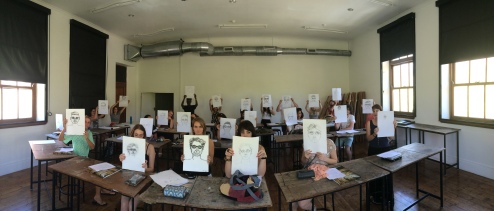Kathryn Smith is completing her PhD at Liverpool John Moores University. A member of FaceLab, her doctoral research project is a cross-cultural consideration of the ethics of professional and public attitudes to visual depictions of the dead in contemporary culture. The research is supported by the National Research Foundation (South Africa).
Portraits, Likenesses, Composites? Facial Difference in Forensic Art

Police colour composite of the alleged ‘Station Strangler’, later identified as Norman Simons. Image courtesy of the Eyewitness Group, University of Cape Town.
The police composite sketch is arguably the most fundamental example of forensic art, and one which enjoys considerable cultural prominence. Intended to produce a positive identification of a specific individual, composites are a form of visual intelligence rather than hard evidence. Based on verbal descriptions drawn from memory deriving from highly contingent and possibly traumatic events, composites are by definition unique and precarious forensic objects, representing an epistemological paradox in their definition as simultaneous ‘artistic impression’ and ‘pictorial statement’. And despite decades of operational use, only in recent years has the field of cognitive psychology begun to fully understand and address the conditions that affect recognition rates both positively and negatively. How might composites contribute to our understanding of representational concepts such as ‘likeness’ and ‘accuracy’? And what role does visual medium – drawn, photographic or computerized depiction – play in the legibility of these images? Situated within the broader context of forensic art practices, this paper proceeds from an understanding that the face is simultaneously crafted as an analogy of the self and a forensic technology. In other words, the face is a space where concepts of identification and identity, sameness and difference (often uncomfortably) converge. With reference to selected examples from laboratory research, field application and artistic practice, I consider how composites, through their particular techniques and form, contribute to subject-making, and how they embody the fugitive, in literal and figurative terms.
Keywords: forensic art; memory; composites; facial features; justice; proof
Appearing in Approaches to Facial Difference: Past and Present (Bloomsbury: 2018).

Portrait Machine: Kathryn Smith 2014 With thanks to Trasi Henen, the Stellenbosch University Fine Arts Drawing II class, and Lucy Jane Turpin Courtesy Kathryn Smith

Portrait Machine: Kathryn Smith 2014 With thanks to Trasi Henen, the Stellenbosch University Fine Arts Drawing II class, and Lucy Jane Turpin Courtesy Kathryn Smith


Pingback: New Publication! Approaching Facial Difference: Past and Present | Effaced From History?